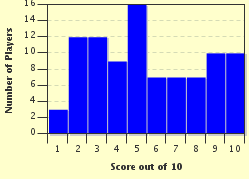Quiz Answer Key and Fun Facts
1. Seth was described as having many wives, but which of his wives was also his older sister?
2. Many Egyptian deities are associated with animals whose behaviour reflects the role of that specific god. Aside from the obscure and possibly imaginary animal whose head Seth is usually portrayed as having, why is Seth often associated with a pig?
3. When Egyptian mythology began to be influenced more and more by the Greeks, with which figure, known as the "Father of All Monsters" did Seth become associated?
4. Which instrument often carried by Seth was originally associated with pharaonic power but soon became linked to chaos?
5. A curious turn of events in the battle between Seth and his nephew Horus comes when Horus sprinkles semen onto Seth's favourite food. Which food, which might be more used to having vinaigrette drizzled on it, was this?
6. In another myth, Seth's testicle is removed by Horus. This added to Seth's association with which geological features?
7. Despite his trickery while fighting Horus, Seth was actually a very strong and brave god. Which of these acts gained Seth much respect amongst his fellow gods?
8. The many evil-doings of Seth seem to be relatively late additions to the myths of ancient Egypt. Indeed, Seth was originally a benevolent god of Upper Egypt. What is the major reason for Seth's transformation into an evil figure?
9. TRUE or FALSE. Despite the demonisation of Seth, he enjoyed a resurgence of popularity and many pharaohs even took his name.
10. After the council of gods failed to come to a unanimous decision over who (Horus or Seth) should become king, one god's words condemned Seth to lose his claim to the crown. Which god was this?
Source: Author
doublemm
This quiz was reviewed by FunTrivia editor
looney_tunes before going online.
Any errors found in FunTrivia content are routinely corrected through our feedback system.

